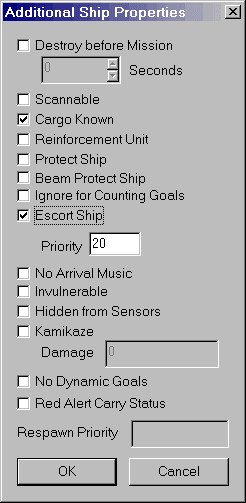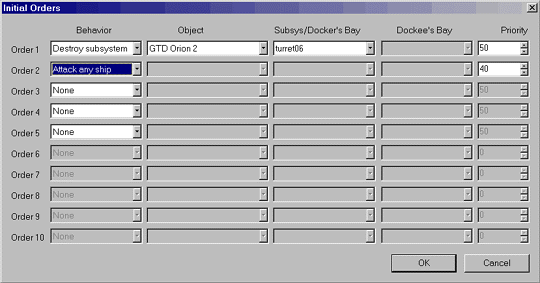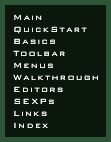This editor lets you change the characteristics of an individual
ship. By marking several ships, you can edit them all at once (for
example, turn them all hostile).
Many of the things that can be done with the Ships Editor
can also be done with the Wings Editor. When dealing with
wings, use the Wings Editor whenever you have a choice.
At the upper left of this editor is a pull-down menu to let you
select a ship. When you first open it, the Ships Editor
has all currently marked ships selected. Any fields (such as
Name) which are not the same for all ships will be blank.
In the upper right are Prev and Next buttons, which
let you cycle through the ships in your mission. Delete
deletes the currently marked ships, and Reset resets
everything in the Ships Editor to default values.
Main Area

You can change the
Name and
Class of a ship here.
You can also set skill the of AI (Artificial
Intelligence) controlling this ship. Skill levels range
from Lieutentant to General. Coward will attempt to evade.
None will react little and take no initiative.
There are four teams to which a ship can belong: Hostile,
Friendly, Neutral, and Unknown. In a single-player mission, the
player is always Friendly. By default, Hostile ships will attack
Friendly and Neutral ships. Friendly ships will attack Hostile
and Neutral ships. Neutral ships will attack Friendly ships. (In
FreeSpace 1, the Hammer of Light was Neutral.) Unknown ships will
only attack Hostile ships. (There is also the Traitor team which is
attacked by everybody, including other Traitors, but not by Unknown.
This is automatically assigned to a player who fires on friendly ships
for a sustained period of time.)
Cargo indicates what, if anything, this ship is carrying.
This is used mostly for transports, of course. The button at the
right side of this field lets you select from a list of cargoes on
other ships in this mission.
If you specify something in the Alt Name field, this will be
shown as the ship's class in the player's HUD. This way, the player
can't tell what something is just by targeting it.
If this ship is part of a Wing, this is indicated.
Hotkey lets you assign a default hotkey for pilots to
target this ship. More than one ship can have the same hotkey;
pressing it in flight will target all such ships.
F5 through F8 are generally reserved for Alpha, Beta, Gamma, and Delta
wings. You should use F9 through F12 for the ships the player is most
likely to target: freighters being escorted, stations being guarded,
capital ships being attacked.
The player can alter their hotkey setup during the game. (The default
key for doing this is F4.) If a ship's arrival is supposed to be a
surprise, you don't want the player to see it when they do this. In this
situation, give the ship the hotkey Hidden.
Persona is used for fighters and bombers. It determines which
video and sound
clips are played for chatter from this ship. There's really not too
much difference between them, but note which are male and which are
female;
if you're going to have fighters send radio messages, they
should match the automatic messages at least in gender.
Score is the number of points (toward promotion) the player
earns for destroying this ship. Player Ship is checked for
ships flown by a player.
Weapons

Pressing the
Weapons button opens the
Weapons Editor.
Here, you can change the weapons mounted on the ship, as well as the
AI class of each gunner. (These are just the default settings.
Players can be given some choice as to their weaponry with the
Team
Loadout Editor.)
Pilot is not a weapon mounting point; this is just another way to set
the pilot's AI class, equivalent to setting it in the main Ships
Editor.
Some weapons cannot be mounted in some positions; you can't put a
capital ship beam weapon on a fighter.
Player Orders

This dialog box lets you choose which orders a ship will accept from a
player. The example at right is for a fighter; there will be fewer
options for a capital ship, which does not have such a sophisticated
AI.
Special Explosion

This lets you provide an unusual explosion when and if this ship is
destroyed. Damage is the amount of damage taken by ships
caught within the Inner Damage Radius of this ship when it
blows. The amount of damage decreases steadily out to the Outer
Damage Radius, where no damage is taken. Blast determines
how hard anyone caught in the explosion is pushed away from it. The
Shockwave is the blue visual effect seen on some large
explosions.
Additional Ship Properties (Misc)

Pressing the
Misc button brings up a dialog box.
You can
have a ship destroyed a certain number of seconds before a mission
(leaving debris).
If a ship is marked Scannable, the player can scan it the same
way they would inspect a cargo vessel. These are different things:
scanning just changes the ship's status from Not Scanned to
Scanned, but inspecting reveals the ship's cargo. Any ship which
does not have Cargo Known can be inspected.
If a ship is a Reinforcement Unit, it can be called into the mission by the
player.
If you check Protect Ship, no AI-controlled ship will attack
this one. Beam Protect
Ship merely prevents capital ship beams from targeting this ship.
(These can
both be overriden by explicit beam firing orders, given with the
fire-beam SEXP operator.)
Ignore For Counting Goals takes this ship out of consideration
in SEXP operators like percent-ships-destroyed.
Any ship marked as an Escort Ship will show up in the Monitor
Display on the right side of the player's HUD. There is only room for
three ships here, so FreeSpace 2 will pick the three escort ships with
the highest priority values. Any Asteroid on a collision course
with an escorted ship will be bracketed in white when the mission is played.
No Arrival Music disables the dynamic fanfare when this ship
arrives.
A ship which is Invulnerable takes no damage, even from
collisions. This is useful for ships which have to survive for plot
reasons, such as the SC Lucifer in FreeSpace 1. It is also extremely
useful in testing: by making Alpha 1 invulnerable, you can fly around
and watch the action without fear of being destroyed. Don't forget to
uncheck this when you're done with the mission!
A ship which is Hidden From Sensors will not show up clearly on
radar and cannot be targeted. It is still visible to the naked eye.
A Kamikaze ship will ram its target, destroying itself and
doing the indicated amount of damage.
If No Dynamic Goals is checked, the ship will stick to its
assigned orders. Otherwise, it will stop to defend itself if it feels
sufficiently threatened.
In a campaign, a mission can be designated as a Red Alert mission.
(This is done in the Mission Specs Editor.)
In
this kind of mission, the player has not had the chance to return to
their base ship for repairs. Other ships in the previous mission with
Red Alert Carry Status will be brought along into Red Alert
mission.
When a player ship is destroyed in a multiplayer mission, the player
will respawn near the ship with the highest Respawn Priority.
Initial Status Editor

This dialog box lets you control various aspects of the ship's initial
status.
Velocity is the ship's initial speed. Note that ships may
quickly change velocity to carry our orders or position themselves
within wings. Also, ships emerging from hyperspace have a high
initial velocity regardless of how this is set.
If a ship is supposed to be damaged at the beginning of a mission,
reduce its Hull Integrity below 100. You can also adjust the
integrity of individual subsystems, such as engines and turrets. If
you don't want to do all this by hand, consider using the
subsys-set-random SEXP operator.
Unchecking Has Shield System will render a fighter or bomber
shieldless. This box has no effect on larger ships.
If Locked is checked, the player cannot change the class or
weapon loadout of the ship before launching the mission.
A ship can begin Docked With another ship, if they share
appropriate docking point. In some situations, you will have a choice
as to where a ship will dock. A ship can only be docked with one
other ship at a time. To see where the docking points are located,
turn on Show Model Dock Points in the View Menu.
The field labeled Cargo here doesn't do anything.
Initial Orders

Here you can specify what the ship is trying to do at the beginning of
the mission. New orders can be given later using the
Events Editor.
The orders that can be
given here are equivalent to those that can be given later with
SEXPs, so we'll skip the detailed explanation for now. We will
note that the word Attack is used here where chase is
used in the SEXP operators.
Although there appears to be room for them, you can't give a ship more
than 5 initial orders. You can give additional orders using the Events Editor.
Arrival and Departure Cues

Here you can control when the ship enters and leaves the mission. By
default, the ship is present when the mission starts, and never
leaves. If you want the Ship Editor window to be smaller,
clicking on Hide Cues will toggle this part of it on or off.
Choices for Location are Hyperspace, Near
Ship, In Front Of Ship, and Docking
Bay. If you choose anything but hyperspace, you must also
select a Target ship to be near and a distance.
The Cue itself is a SEXP. The ship will arrive or
depart after this becomes true and then the number of seconds given in
Delay has passed.
Check No Warp Effect if this would be inappropriate, such as
when a fighter is launching from a destroyer or when a ship is
appearing in the distance in a nebula.
The area at the bottom (which may extend below the edge of your
screen) is the SEXP help, explaining the currently highlighted
SEXP. In the unlikely event that you want to turn this off,
you can do so in the Help Menu.


